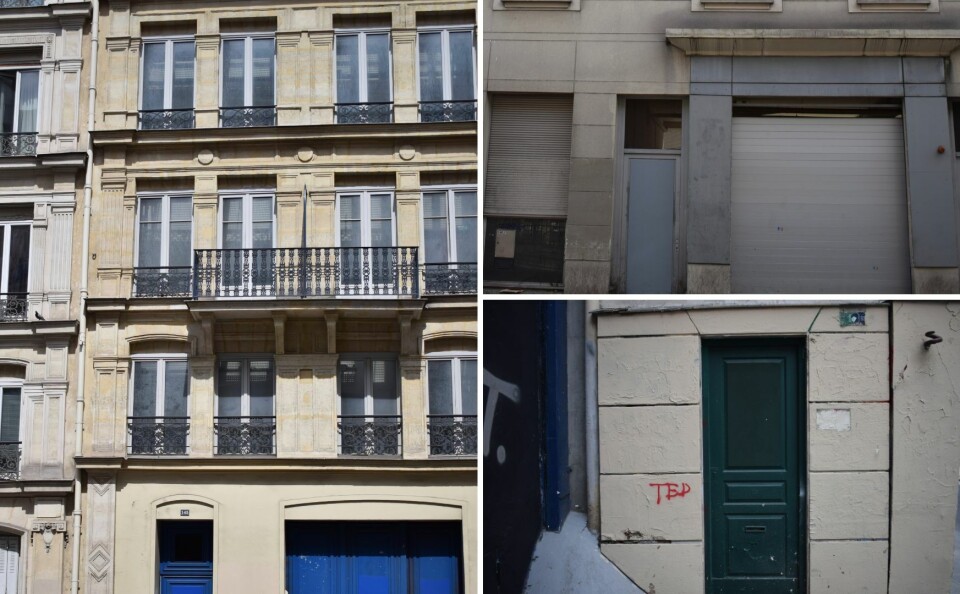-
Floor collapses in Paris building leaving 20 injured
Water leaking into the building from balcony is thought to be cause of collapse
-
Black history in Paris: the story behind Maison Noire Américaine
An American non-profit is illuminating the legacy and vibrant presence of African-Americans and the African diaspora in France
-
Drinking tap water restricted for children in south-west France communes
Haute Garonne prefecture says the measure is precautionary and due to high chlorate levels
Architecture of France: fake Paris façades cover up pollution secret
The Parisien 'fausses façades' look clever but actually hide engineering infrastructure emitting unsafe levels of fine particles says environmental group

Twelve buildings dotted around Paris and mimicking the style of the city’s traditional Haussmann buildings are actually little more than shells, which use fausses façades (fake façades) to hide engineering infrastructure inside.
Unbeknown even to some locals, the façades blend in with the traditional urban landscape of Paris since they are painted the same pale colour and often decorated with trompe-l’oeil balconies, windows or doors, albeit with no handles or door codes.
Behind lie empty corridors.
Facades hide ugly works
Most hide technical engineering structures from RATP’s RER system or EDF transformers, but two host a data centre and elaborate artwork.
The buildings can be found in eight of Paris’s 20 arrondissements – the 2nd, 3rd, 4th, 9th, 10th, 12th, 17th and 19th – though 75% are concentrated in just four districts: the 2nd, 3rd, 9th and 10th.
These bizarre buildings have fuelled countless blog posts by photographers and city strollers (flâneurs), plus quirky mentions in Paris guidebooks, but at least one environmental association has denounced them for masking air pollution, highlighting that emissions of fine particles from behind the walls exceed safe levels.
Ventilation shaft for subway trains
The city’s most famous fake façade is located on 145 rue Lafayette in the 10th arrondissement.
The five-storey building is 7m wide and 6m deep and features two blue-painted doors.
Hang around, however, and you will soon realise they never open, nor are you likely to see anyone behind the elegant upstairs windows.
The original building was destroyed in the 1980s and a new façade built to hide a huge ventilation shaft when RATP extended the underground RER B line from Châtelet to Gare du Nord.
Google Earth reveals what façades hide
The building was referenced in Umberto Eco’s 1988 Foucault’s Pendulum as the entrance to the underworld, and again in La Conjuration, journalist Philippe Vasset’s 2013 novel exploring Paris’s empty, abandoned and interstitial spaces.
Several other buildings have followed suit nearby and host similar ventilation shafts along the RER B line, such as 174 rue du Faubourg Saint-Denis (10th arrondissement), 29 rue Quincampoix (4th arrondissement), and 44 rue d’Aboukir (2nd arrondissement).
RATP has also taken over two other buildings on 54 rue des Petites Écuries (10th arrondissement) and 141 boulevard Diderot (12th arrondissement) to position high-voltage power lines.
As with the ventilation units, they can be seen on Google Earth images by zooming in on the buildings.
Electricity provider EDF has also taken spots behind fake façades, with three transformers installed on 53 rue des Archives (3rd arrondissement), 14 rue Duvergier (19th arrondissement) and 27 rue Bergère (9th arrondissement).
Datacentre hidden
Whereas some fake façades blend almost seamlessly in with the rest of the street, the buildings on rue Bergère and rue Duvergier are notable exceptions.
Ugly tiled and concrete walls in need of TLC contrast sadly with their taller, classic Haussmann-style neighbours.
At 78 rue La Condamine (17th arrondissement), a 1970s fake façade with wooden doors and wooden-framed windows hides Global Service Provider, a French company providing cloud computing services.
A representative confirmed to The Connexion that the firm hosted a datacentre here.
Installation art
Rue Chapon (3rd arrondissement) boasts the last listed fake façade of Paris.
It did not exist until 2006 when artists Julien Berthier and Simon Boudvin installed a new door on a wall there – leading nowhere – as part of a work called Les Spécialistes.
The fake entrance measures 2.2m tall and 2m wide and bears a fake house number, 1 bis, and a plaque which reads ‘J.B. & S.B. spécialistes’.
A fake doorbell and letterbox complete the façade.
The creation was installed in less than 30 minutes early one Saturday morning and looks so realistic that it is regularly graffitied and then cleaned by city services.
Respire group want transparency
However, these architectural curiosities are not always a joke, as environmentalists at Respire, a French group fighting for better air quality, are keen to point out.
The association partnered with YouTuber Vintage Tran, a parkour athlete who explores urban areas by running, jumping and climbing obstacles, for a video last July.
In it, he is seen slipping inside one of the RATP-owned buildings to record the level of fine particles being emitted from the transport system below.
They peak at 79 micrograms per cubic metre, way above the limit of 25 set by the EU.
The World Health Organisation cites an even lower figure, 20.5 micrograms per cubic metre, as a pollution peak.
Tony Renucci, 31, director of Respire, said: “This is worrying. People do not know what is hiding behind and how harmful it is for their health.”
He is pushing for greater transparency from RATP about what lies behind the fake façades and expects the organisation to install more units to measure air quality, as well as investing in better technology to limit the spread of fine particles from the train brakes underground.
Related articles
Crit’Air: Paris limits access of certain cars as pollution spikes
The ‘ideal town of tomorrow’ imagined by the French public
Paris to have a ‘manifesto for beauty’ after social media criticism
























